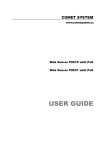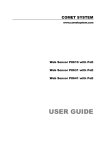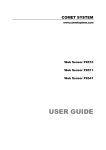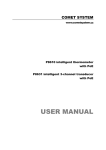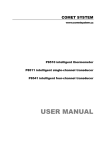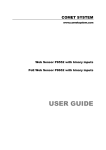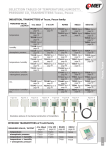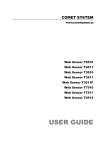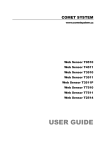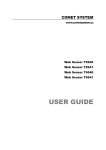Download USER MANUAL - Sincro Systems
Transcript
COMET SYSTEM www.cometsystem.cz P8610 intelligent thermometer with PoE P8631 intelligent 3-channel transducer with PoE USER MANUAL IE-SNC-P86xx-02 © Copyright: COMET System, Ltd. Is prohibited to copy and make any changes in this manual, without explicit agreement of company COMET System, Ltd. All rights reserved. COMET System, Ltd. makes constant development and improvement of their products. Manufacturer reserves the right to make technical changes to the device without previous notice. Misprints reserved. Manufacturer is not responsible for damages caused by using the device in conflict with this manual. To damages caused by using the device in conflict with this manual can not be provide free repairs during the warranty period. This user manual describes device with firmware version 4-5-5.x. For devices with older firmware version 4-5-1.x please read manual IE-SNC-P86xx-01. 2 IE-SNC-P86xx-02 Table of contents Introduction........................................................................................................................................................ 4 General safety rules ..................................................................................................................................... 4 Device description and important notices ............................................................................................... 5 Getting started.................................................................................................................................................... 6 What is needed for operation .................................................................................................................... 6 Mounting the device.................................................................................................................................... 6 Device settings ............................................................................................................................................. 7 Checking functions ...................................................................................................................................... 9 Device setup .....................................................................................................................................................10 Setup using web interface .........................................................................................................................10 Setup using TSensor software .................................................................................................................17 Factory defaults ..........................................................................................................................................17 Communication protocols .............................................................................................................................19 Website ........................................................................................................................................................19 SMTP – sending e-mails ...........................................................................................................................19 SNMP ..........................................................................................................................................................20 Modbus TCP ..............................................................................................................................................21 SOAP ...........................................................................................................................................................22 Syslog ...........................................................................................................................................................23 SNTP ...........................................................................................................................................................23 Troubleshooting...............................................................................................................................................24 I forgot the device IP address..................................................................................................................24 I can not connect to the device ...............................................................................................................24 Error or n/a is displayed instead the measured value .........................................................................25 Error2 is displayed on all channels instead the measured value.........................................................25 I forgot the password for setup ...............................................................................................................25 Factory defaults ..........................................................................................................................................25 Technical specifications ..................................................................................................................................26 Dimensions .................................................................................................................................................26 Basic parameters ........................................................................................................................................27 Operating terms .........................................................................................................................................28 End of operation .......................................................................................................................................29 Technical support and service .................................................................................................................29 Preventive maintenance ............................................................................................................................29 Optional accessories ........................................................................................................................................30 3 IE-SNC-P86xx-02 1 Chapter Introduction This chapter provides basic information about device. Before starting please read this manual carefully. P8610 Intelligent Thermometer and P8631 Transducer are used to measure temperature or relative humidity. Temperature can be displayed in °C or °F. Relative humidity have unit %RH. Communication with the device is realized via Ethernet network. Device can be powered from external power supply adapter or by using power over Ethernet – PoE. P8610 Thermometer has compact design and measures the temperature in place of installation. To P8631 Transducer is possible connect up to three probes. Temperature or humidity probes are available as optional accessories. General safety rules The following summary is used to reduce the risk of injury or damage the device. To prevent injury, please follow instructions in this manual. The device can be services only by a qualified person. The device contains no serviceable parts inside standard means. Don’t use the device, if it doesn’t work correctly. If you think, that the device is not working correctly, let check it by qualified service person. Don’t disassemble the device. It’s forbidden to use the device without the cover. Inside the device can be a dangerous voltage and may be risk of electric shock. Use only the appropriate power supply adapter according to manufacturer specifications and approved according to relevant standards. Make sure, that the adapter does not have damaged cables or covers. Connect the device only to network parts approved according to relevant standards. Where power over Ethernet is used, the network infrastructure must be compatible with IEEE 802.3af standard. Connect and disconnect the device properly. Don’t connect or disconnect Ethernet cable or probes, if the device is powered. 4 IE-SNC-P86xx-02 The device may be installed only in prescribed areas. Never expose the device to higher or lower temperatures than is allowed. The device has not improved resistance to moisture. Protect it from dripping or splashing water and do not use at areas with condensation. Don’t use device in explosive environments. Don’t stress the device mechanically. Device description and important notices This chapter contains informations about basic features. Also there are important notices concerning to functional safety. Values from the device can be read using an Ethernet connection. The following formats are supported: Web pages with user changeable look and XML files Modbus TCP protocol SNMPv1 protocol SOAP protocol The device can also be used to check measured values and if the limit is exceeded, device sends warning messages. Possible ways to sending warning messages: Sending e-mails up to 3 e-mail addresses Sending SNMP traps up to 3 configurable IP addresses Displaying the alarm status on web page Sending messages to Syslog server The device setup can be made by the TSensor software or web interface. TSensor software can be free downloaded from the manufacturer’s website. Also you will find there latest firmware for your device. Do not upload to your device firmware which is not designed for it. Unsupported firmware can damage your device. If you want to use PoE, you must use PoE switch compatible with IEEE 802.3af standard. As a low cost solution can be recommended Repotec switch RP-PE8T/4. Reliability of warning messages delivering (e-mail, trap, syslog), depends on actual availability of necessary network services. The device should not be used for critical applications, where malfunction could cause to injury or loss of human life. For highly reliable systems, redundancy is essential. For more information please see standard IEC 61508. Never connect the device directly to the Internet. If it is necessary connect the device to the Internet, properly configured firewall must be used. Firewall can be partially replaced with the NAT. 5 IE-SNC-P86xx-02 2 Chapter Getting started Here you can find informations necessary to put newly purchased equipment to operation. This procedure is only informative. What is needed for operation To install the unit you need to the following equipment. Before installation check if it’s available. P8610 Thermometer or P8631 Transducer power supply adapter 5V/250mA or switch with PoE. Before using the device is necessary to decide which way of powering will be used. RJ45 LAN connection with appropriate cable free IP address in your network for P8631 Transducer up to 3 temperatures probes type DSTR162/C, DSTGL40/C, DSTG8/C or relative humidity probe DSRH Mounting the device check if the equipments from previous chapter are available install the latest version of TSensor software. This software is used to all device settings. TSensor software can be free downloaded from the manufacturer’s website. Software can be also supplied on CD. Device configuration can be made using web interface. For web configuration is not TSesnor software necessary. contact your network administrator to obtain following informations for the connection to the network: IP address: Gateway: Netmask: _____._____._____._____ _____._____._____._____ _____._____._____._____ 6 IE-SNC-P86xx-02 check if there is no IP address conflict when you connect the device into network for the first time. The device has from factory set the IP address to 192.168.1.213. This address must be changed according to informations from the previous point. When you installing several new devices, connect them to the network one after another. connect probes to P8631 Transducer connect the Ethernet connector if the power over Ethernet (PoE) is not used, connect the power adapter 5V/250mA LEDs on LAN connector should blink after connecting the power P8610 Thermometer connection (power supply adapter, Power over Ethernet): P8631 Transducer connection (power supply adapter, Power over Ethernet): Device settings run configuration software TSensor on your PC switch to an Ethernet communication interface press button Find device... 7 IE-SNC-P86xx-02 the window shows all available devices on your network click to Change IP address to set new address according to network administrator instructions. If your device is not listed, then click Help! My device wasn’t found! Then follow the instructions. MAC address is on product label. The device is factory set to IP 192.168.1.213. gateway may not be entered if you want to use the device only in local network. If you set the same IP address which is already used, the device will not work correctly and there will be collisions on the network. If the device detects a collision of IP address then reboot is performed automatically. after changing IP address device is restarted and new IP address is assigned. Restart of the device takes about 10 seconds. connect to device using TSensor software and check the measured values. If P8631 Transducer values are not displayed, it’s necessary to find probes using button Search probes (Find probes). 8 IE-SNC-P86xx-02 set the other parameters (alarm limits, SMTP server, etc.). Settings are saved after click on button Save changes. Checking functions The last step is to check measured values on the device website. In the address bar of the web browser, enter the device IP address. If the default IP address was not changed, then insert http://192.168.1.213. Displayed web page lists actual measured values. If the web pages are disabled, you can see text Access denied. If the measured value exceeds the measurement range or probe is not correctly installed, then is shown Error message. If the channel is switched off, the web site displayed n/a instead of the value. 9 IE-SNC-P86xx-02 3 Chapter Device setup This chapter describes basic device configuration. There is a description of settings using web interface. Setup using web interface Device can be setup using web interface or TSensor software. Web interface can be managed by the web browser. Main page will be shown when you insert device address into address bar of your web browser. There you find actual measured values. Page with history graphs is shown when you click to tile with actual values. Access to device setup is possible via tile Settings. 10 IE-SNC-P86xx-02 General Device name can be changed using item Device name. Measured values are stored into memory according History storage interval field. After changing of this interval all history values will be cleared. Changes must be confirmed by Apply settings button. Network Network parameters can be obtain automatically from DHCP server using option Obtain an IP address automatically. Static IP address is configurable via field IP address. It is not necessary setup Default gateway while you use device inside one subnet only. Option Standard subnet mask sets network mask automatically according A, B or C network class. Subnet mask field must be set manually, when network with non standard range is used. Periodic restart interval enables to restart device after selected time since device start. 11 IE-SNC-P86xx-02 Alarm limits For each measurement channel is possible to set upper and lower limits, time-delay for alarm activation (0 – 65535s) and hysteresis for alarm clearing. Example of setting the limit to the upper alarm limit: In Point 1 the temperature exceeded the limit. From this time, the time-delay is counting. Because at point 2 the temperature dropped below the limit value before the time delay expired, alarm was not set. In Point 3 the temperature has risen over limit again. During the time-delay the value does not drop below the set limit, and therefore was in Point 4 caused alarm. At this moment were sent e-mails, traps and set alarm flag on website, SNMP and Modbus. The alarm lasted up to Point 5, when the temperature dropped below the set hysteresis (temperature limit – hysteresis). At this moment was active alarm cleared and e-mail send. When alarm occurs, alarm messages will be sent. In case of power failure or device reset (e.g. changing the configuration) will new alarm state evaluated and new alarm messages will be send. 12 IE-SNC-P86xx-02 Channels Channel can be enabled or disabled for measuring using item Enabled. Channel can be renamed (max. 14 characters) and it is possible select unit of measured value according connected probe type. When channel is not used, it is possible copy to it one of other channels – option Clone channel. This option is not available at fully occupied device. Find sensors button starts searching for connected probes. All changes must be confirmed using Apply settings button. History values are cleared after changing of channel settings. SOAP protocol SOAP protocol can be enabled by option SOAP protocol enabled. IP address of the destination http server is configurable via SOAP server IP address filed. For setup of destination server port can be used option SOAP server port. Target place of the http server can be set via SOAP server target place. Device send SOAP message according selected Sending interval. Option Send SOAP message when alarm occurs sends message when an alarm on channel occurs or alarm is cleared. These SOAP messages are sent asynchronously to selected interval. 13 IE-SNC-P86xx-02 Email Email sending enabled option allows email features. It is necessary set address of the SMTP as IP address into SMTP server IP address field. Default port of the SMTP server can be changed using item SMTP server port. SMTP authentication can be enabled using SMTP authentication option. When authentication is enabled Username and Password must be set. For successfully email sending it is necessary insert Email sender address. This address is usually same as username of the SMTP authentication. Into fields Recipient 1 to Recipient 3 it is possible set address of email recipients. Option Short email enable sending emails in short format. This format is usable when you need to forward emails into SMS messages. When option Alarm email repeat sending interval is enabled and there is active alarm on channel, then emails with actual values are sent repeatedly. Info email sending interval option enables sending emails at selected time interval. CSV history file can be sent together with the repeat/info emails. This feature can be enabled by Alarm and Info emails attachment option. It is possible to test email function using button Apply and test. This button save a new settings and send a testing email immediately. 14 IE-SNC-P86xx-02 Modbus a Syslog protocols ModbusTCP and Syslog protocol settings are configurable via menu Protocols. Modbus server is enabled by default. Deactivation is possible via Modbus server enabled option. Modbus port can be changed via Modbus port field. Syslog protocol can be enabled using item Syslog enabled. Syslog messages are sent to IP address of the Syslog server - field Syslog server IP address. SNMP For reading values via SNMP it is necessary to know password - SNMP read community. SNMP Trap can be delivered up to three IP address - IP address of the Trap recipient. SNMP Traps are sent at alarm or error state on the channel. Trap feature can be enabled by option Trap enabled. 15 IE-SNC-P86xx-02 Time Time synchronization with SNTP server can be enabled by Time synchronization enabled option. IP address of the SNTP is necessary to set into SNTP server IP address item. SNTP time is synchronized at UTC format, and due to be necessary set corresponding time offset - GSM offset [min]. Time is synchronized every 24 hours by default. Option NTP synchronization every hour decrease this synchronization interval to one hour. WWW and security Security features can be enabled by the Security enabled option. When security is enabled it is necessary to set administrator password. This password will be required for device settings. When secured access is required even to actual values reading it is possible to enable User account only for viewing. Port of the www server can be changed from the default value 80 using filed WWW port. Web pages with actual values are refreshed according to Web refresh interval field. 16 IE-SNC-P86xx-02 Setup using TSensor software TSensor software is an alternative to web configuration. Some less important parameters are configurable only by the TSensor software. Parameter MTU size can reduce size of the Ethernet frame. Lowering of this size can solve some communication problems mainly with Cisco network infrastructure. Sensor software can set offset of values at temperature probes. At DSRH humidity probe is possible set correction of the humidity and temperature. Factory defaults Factory defaults button set the device into factory configuration. Network parameters (IP address, Subnet mask, Gateway) are left without changes. Network parameters are changed while you close jumper inside the device. After jumper closing it is necessary connect power supply. Factory defaults have no effect to user correction inside probe. Factory parameters settings: Parameter Value IP address of SMTP server SMTP server port Alarm email repeat sending interval Info email repeat sending interval Repeat email attachment E-mail recipients addresses E-mail sender SMTP authentication SMTP user/SMTP password E-mail sending enabled IP addresses SNMP traps recipients 0.0.0.0 25 off off off cleared sensor@IP off cleared off 0.0.0.0 17 IE-SNC-P86xx-02 Password for SNMP reading Sending SNMP Trap Website refresh interval [sec] Website enabled Website port Security Administrator password User password Modbus TCP protocol port Modbus TCP enabled History storage interval [sec] SOAP server IP address SOAP destination port SOAP server target place SOAP sending interval [sec] SOAP protocol enabled Syslog server IP address Syslog protocol enabled SNTP server IP address GMT offset [min] NTP synchronization every hour SNTP synchronization enabled MTU Periodic restart interval Demo mode Turn on all channels Upper limit Lower limit Hysteresis – hysteresis for alarm clearing Delay – time-delay of alarm activation [sec] Unit on the channel Channel name Device name 18 public off 10 yes 80 off cleared cleared 502 yes 60 0.0.0.0 80 cleared 60 off 0.0.0.0 off 217.31.205.226 0 off off 1400 off off yes 50 0 1 30 °C or %RH according used probe Channel X (where X is 1 to 5) PoE Ethernet Thermometer, etc. IE-SNC-P86xx-02 4 Chapter Communication protocols Short introduction to communication protocols of the device. To use some communication protocols is necessary software, which can use the protocol. This software is not included. Detailed description of protocols and application notes can be found in the manual appendix. Website The device supports displaying of measured values, history graphs and configuration using web browser. History graphs are based on HTML5 canvas. Web browser must support this feature for proper function of graphs. Firefox, Opera, Chrome or Internet Explorer 9 can be used. If the device has IP address 192.168.1.213 type into your browser http://192.168.1.213. Using TSensor software or web interface can be set automatic webpages refresh in interval. The default value is 10sec. Actual measured values can be obtained using XML file values.xml. Values from history can be exported in CSV format. History storage interval can be set using TSensor software or web interface. History is erased after every reboot of the device. Reboot of the device is performed when the power supply is disconnected and also after configuration change. The device allows you to customize the design of web pages. Details of how to change the design, you can find in the manual appendix. Manual appendix can be obtained from the manufacturer’s website. SMTP – sending e-mails When measured values are over the set limits, the device allows send e-mail to a maximum of 3 addresses. E-mail is send when alarm condition on the channel is cleared or a measuring error occurs. It is possible to set repeat interval for email sending. For correct sending of e-mails it is necessary to set IP address of SMTP server. SMTP authentication is supported but SSL not. Standard SMTP port 25 is used by default. SMTP port can be changed. Contact your network administrator to obtain configuration parameters of your SMTP server. E-mail sent by the device can not be answered. 19 IE-SNC-P86xx-02 SNMP Using SNMP protocol you can read actual measured values, alarm status and alarm parameters. Via SNMP protocol is also possible to get last 1000 measured values from history table. Writing via SNMP protocol is not supported. It is supported SNMPv1 protocol version only. SNMP used UDP port 161. OID keys description can be found in the MIB table, which can be obtained from device website or from your distributor. The password for reading is factory set to public. The changes can be made using TSensor software or web interface. OID keys: OID Description Type .1.3.6.1.4.1.22626.1.5.1 .1.3.6.1.4.1.22626.1.5.1.1 .1.3.6.1.4.1.22626.1.5.1.2 .1.3.6.1.4.1.22626.1.5.1.3 .1.3.6.1.4.1.22626.1.5.2.ch .1.3.6.1.4.1.22626.1.5.2.ch.1 .1.3.6.1.4.1.22626.1.5.2.ch.2 .1.3.6.1.4.1.22626.1.5.2.ch.3 .1.3.6.1.4.1.22626.1.5.2.ch.4 .1.3.6.1.4.1.22626.1.5.2.ch.5 .1.3.6.1.4.1.22626.1.5.2.ch.6 .1.3.6.1.4.1.22626.1.5.2.ch.7 .1.3.6.1.4.1.22626.1.5.2.ch.8 .1.3.6.1.4.1.22626.1.5.2.ch.9 .1.3.6.1.4.1.22626.1.5.2.ch.10 .1.3.6.1.4.1.22626.1.5.3.1.0 .1.3.6.1.4.1.22626.1.5.4.1.1.ch.nr Device informations Device name String Serial number String Device type Integer Measured value (where ch is channel number) Channel name String Actual value – text String Actual value Int*10 Alarm on channel (0/1/2) Integer High limit Int*10 Low limit Int*10 Hysteresis Int*10 Delay Integer Unit String Alarm on channel – text String SNMP Trap text String History table value String When alarm occurred a warning messages (trap) can be sent to selected IP addresses. Addresses can be set using TSensor software or web interface. Traps are sent via UDP protocol on port 162. The device can send following traps: Trap Description 0/0 1/0 6/0 6/1 6/2 6/3 6/4 6/5 6/6 6/7 6/8 6/9 6/11 – 6/15 6/21 – 6/25 6/31 – 6/35 6/41 – 6/45 Reset of the device Settings was changed Testing Trap NTP synchronization error SMTP server login error SMTP authentication error E-mail sending error Some error occurred during SMTP communication TCP connection to server cannot be opened SOAP file not found inside web memory MAC address can't be obtained from IP address SOAP message sending error TCP connection to server cannot be opened Wrong response code from the SOAP server Upper alarm on channel Lower alarm on channel Clearing alarm on channel Measuring error 20 IE-SNC-P86xx-02 Modbus TCP Device supports Modbus protocol for communication with SCADA systems. Device use Modbus TCP protocol. TCP port is set to 502 by default. Port can be changed using TSensor software or web interface. Only two Modbus clients can be connected to device at one moment. Modbus device address (Unit Identifier) can be arbitrary. Modbus write command is not supported. Specification and description of the Modbus protocol is free to download on: www.modbus.org. Supported Modbus commands (functions): Command Code Read Holding Register (s) 0x03 Read Input Register(s) 0x04 Description Read 16b register(s) Read 16b register(s) Modbus device registers. Address could be by 1 higher, depending on type used communication library: Address [DEC] Address [HEX] Value Type 39970 39971 39972 39973 39974 39975 – 39977 39978 – 39979 39980 – 39982 39983 – 39984 39985 – 39987 39988 – 39989 39990 – 39999 40000 40001 40002 40003 40004 40005 40006 40007 40008 40009 40010 40011 40012 40013 40014 40015 40016 40017 1st two digits from serial number 2nd two digits from serial number 3rd two digits from serial number 4th two digits from serial number Device type Actual measured value on channel Unused Unit on the channel Unused Channel alarm state Unused Unused Channel 1 temperature Channel 1 alarm status Channel 1 upper limit Channel 1 lower limit Channel 1 hysteresis Channel 1 delay Channel 2 temperature Channel 2 alarm status Channel 2 upper limit Channel 2 lower limit Channel 2 hysteresis Channel 2 delay Channel 3 temperature Channel 3 alarm status Channel 3 upper limit Channel 3 lower limit Channel 3 hysteresis Channel 3 delay BCD BCD BCD BCD uInt Int*10 n/a Ascii n/a uInt n/a n/a Int*10 Ascii Int*10 Int*10 Int*10 uInt Int*10 Ascii Int*10 Int*10 Int*10 uInt Int*10 Ascii Int*10 Int*10 Int*10 uInt 0x9C22 0x9C23 0x9C24 0x9C25 0x9C26 0x9C27 – 0x09C29 0x9C2A – 0x09C2B 0x9C2C – 0x9C2E 0x9C2F – 0x9C30 0x9C31 – 0x9C33 0x9C34 – 0x9C35 0x9C36 – 0x9C3F 0x9C40 0x9C41 0x9C42 0x9C43 0x9C44 0x9C45 0x9C46 0x9C47 0x9C48 0x9C49 0x9C4A 0x9C4B 0x9C4C 0x9C4D 0x9C4E 0x9C4F 0x9C50 0x9C51 Description: 21 IE-SNC-P86xx-02 Int*10 registry is in format integer*10 – 16 bits uInt registry range is 0-65535 Ascii character BCD registry is coded as BCD n/a item is not defined, should be read no no alarm lo value is lower than set limit hi value is higher than set limit Possible alarm states: SOAP The device allows you to send currently measured values via SOAP v1.1 protocol. The device sends values in XML format to the web server. The advantage of this protocol is that communication is initialized by the device side. Due to it is not necessary use port forwarding. If the SOAP message can not be delivered, warning message via SNMP Trap or Syslog protocol is sent. The file with the XSD schema can be downloaded from: http://cometsystem.cz/schemas/soapP8xxx.xsd. SOAP message example: Host: 192.168.001.132 Content-Type: text/xml; charset=utf-8 Content-Length: 751 SOAPAction: "http://tempuri.org/InsertP8xxxSample" <?xml version="1.0" encoding="utf-8"?> <soap:Envelope xmlns:soap="http://schemas.xmlsoap.org/soap/envelope/" xmlns:xsi="http://www.w3.org/2001/XMLSchema-instance" xmlns:xsd="http://www.w3.org/2001/XMLSchema"> <soap:Body> <InsertP8xxxSample xmlns="http://cometsystem.cz/schemas/soapP8xxx.xsd"> <name>Ethernet Transducer</name> <sn>11940986</sn> <tmr>60</tmr> <kind>4353</kind> <c1> <v>26.3</v> <u>C</u> <a>no</a> <e>1</e> </c1> ... ... ... <c5> <v>-11000</v> <u>n/a</u> <a>no</a> <e>0</e> </c5> </InsertP8xxxSample> </soap:Body> </soap:Envelope> 22 IE-SNC-P86xx-02 Syslog The device allows sending text message to selected Syslog server. Events are send using UDP protocol on port 514. Syslog protocol implantation is according to RFC5424 and RFC5426. Events when Syslog messages are send: Text Event Sensor - fw 4-5-5.x Settings changed NTP synchronization error Testing message Email login error Email auth error Email some error Email socket error SOAP file not found SOAP host error SOAP sock error SOAP delivery error High alarm CHx Low alarm CHx Clearing CHx Error CHx Reset of the device Settings was changed NTP synchronization error Test Syslog message E-mail sending error SOAP message sending error Upper alarm on channel Lower alarm on channel Clearing alarm on channel Measuring error SNTP The device allows time synchronization with NTP (SNTP) server. SNMP protocol version 3.0 is supported (RFC1305). Time synchronization is made every 24 hours. Time synchronization every hour can be enabled. For time synchronization it is necessary set IP address to the SNTP server. It is also possible set GMT offset for correct time zone. Time is used in graphs and history CSV files. Maximum jitter between two time synchronization is 90sec at 24 hours interval. 23 IE-SNC-P86xx-02 5 Chapter Troubleshooting The chapter describes the common problems with P8610 Thermometer, P8631 Transducer and methods how to fix these problems. Pleas read this chapter before you will call technical support. I forgot the device IP address IP address is factory set to 192.168.1.213. If you had changed it and forgot new IP address, run the TSensor software and press Find device... In the window are displayed all available devices. I can not connect to the device In search window is only IP and MAC address displayed Other details are marked N/A. This problem occurs if IP address of the device is set to another network. Select the window Find device in TSensor software and press Change IP address. Follow the software instructions. To assign IP address automatically using DHCP server, set the device IP address to 0.0.0.0. Device IP address is not displayed in window Find device In TSensor software menu press Help! My device was not found! in window Find device. Follow the software instructions. MAC address of the device can be found on product label. The device is not found even after manually setting MAC address This problem occurs especially in cases when the IP address of the device belongs to another network and also Subnet mask or Gateway are incorrect. In this case is DHCP server in the network necessary. In TSensor software menu press Help! My device was not found! in window Find device. As new IP address set 0.0.0.0. 24 IE-SNC-P86xx-02 Follow the software instructions. An alternative is to reset device to factory defaults using factory-defaults button. Error or n/a is displayed instead the measured value Value n/a is shown a shortly after device restart. If the error code or n/a is displayed permanently, check if the probes are connected to device correctly. Make sure that probes are not damaged and inside operating range. Than perform new search of probes using TSensor software or web interface. Error2 is displayed on all channels instead the measured value Error2 indicates short-circuit of measurement bus. Check if correct probes are connected. Probes Pt100/Pt1000/Ni100/Ni1000 can not be used with this device. Make sure that cables of probes are not damaged. I forgot the password for setup Please reset device to factory defaults. Procedure is described at following point. Factory defaults This procedure restore device to factory settings including network parameters (IP address, Subnet mask, etc.). For factory-defaults follow these steps: disconnect the power supply (power adapter or RJ45 connector if PoE is used) use something with thin tipped (e.g. paper clip) and press the hole on the left side connect the power, wait for 10sec and release the button 25 IE-SNC-P86xx-02 6 Chapter Technical specifications Informations about technical specifications of the device. Dimensions P8610 Thermometer: P8631 Transducer: 26 IE-SNC-P86xx-02 Basic parameters Supply voltage: Power over Ethernet according to IEEE 802.3af, PD Class 0 (max. 15.4W), voltage from 36V to 57V DC. For PoE are used pairs 1, 2, 3, 6 or 4, 5, 7, 8. or DC voltage from 4.9V to 6.1V, coaxial connector, 5x 2.1mm diameter, positive pole in the middle, min. 250mA Consumption: ~ 1W depending on the operating mode Protection: IP30 case with electronic Measuring interval: 2sec Accuracy P8610: ±0.8°C in temperature range from -10°C to +60°C ±2.0°C in temperature range from -10°C to -20°C Accuracy P8631 (depending on used probe – e.g. probe DSTR162/C parameters): ±0.5°C in temperature range from -10°C to +80°C ±2.0°C in temperature range from -10°C td -30°C Resolution: 0.1°C 0.1%RH P8610 temperature measurement range: -20°C to +60°C P8631 temperature measurement range (limited by temperature range of used probe): -55°C to +80°C Recommended probe P8631: Temperature probe DSTR162/C max. length 10m Temperature probe DSTGL40/C max. length 10m Temperature probe DSTG8/C max. length 10m Humidity probe DSRH max. length 5m Communication port: RJ45 connector, 10Base-T/100Base-TX Ethernet (Auto-Sensing) Recommended Connector Cable: 27 IE-SNC-P86xx-02 for industrial use is recommended Cat5e STP cable, in less demanding applications can be replaced by Cat5 cable, maximum cable length 100m Supported protocols: TCP/IP, UDP/IP, ARP, ICMP, DHCP HTTP, SMTP, SNMPv1, ModbusTCP, SNTP, SOAPv1.1, Syslog Supported web browsers: Internet Explorer 9, Mozilla Firefox 12 and later, Google Chrome 18 and later, Opera 11 and later, Safari 5 and later. Device should be also compatible with other browsers. Functionality wasn't tested with other web browsers. Recommended minimum screen resolution: 1024 x 768 Memory: 1000 values for each channel inside non-backup RAM memory Case material: ABS Mounting the device: With two holes at the bottom of the unit Weight: P8610 ~ 145g, P8631 ~ 140g EMC emission: EN 61326-1:2006 + cor. 1:2007, Class A, clause 7 EN 55011 ed.3:2010 + cor. A1:2011, ISM equipment group 1, Class A, clause 6.2.2.3 EN 55022 ed.2:2007 + change A1:2008, Class A ITE, clause 5.2 Warning - This is a Class A product. In a domestic environment this product may cause radio interference in which case the user may be required to take adequate measures to correct this interference. EMC resistance: EN 61326-1:2006 + cor. 1:2007 Electrical safety: EN 60950-1 ed. 2:2006 Operating terms Temperature and humidity range in case with electronic: 28 IE-SNC-P86xx-02 -20°C to +60°C, 0 to 100% RH (no condensation) Temperature range of recommended probe DSTR162/C for P8631: -30°C to +80°C Temperature range of probe DSTGL40/C for P8631: -30°C to +80°C Temperature range of probe DSTG8/C for P8511 and P8541: -50°C to +80°C Temperature range of probe DSRH for P8631: 0°C to +50°C P8610 working position: with sensor cover downwards. When mounting in RACK 19" with universal holder MP046 (accessories) then sensor cover can be placed horizontally. P8631working position: arbitrary End of operation Disconnect the device and dispose it according to current legislation for dealing with electronic equipment. Electronic devices must be professionally destroyed in accordance with EU Directive 2002/96/ES of 27th January 2003. Technical support and service Technical support and service is provided by distributor. Contact is included in warranty certificate. Preventive maintenance Make sure the cables and probes are not damaged periodically. Recommended calibration interval is 2 years. Recommended calibration interval for device with humidity probe DSRH is 1 year. 29 IE-SNC-P86xx-02 7 Chapter Optional accessories This chapter contains list of optional accessories, which can be ordered by extra cost. Manufacturer recommends using only original accessories. Temperature probe DSTR162/C Temperature probe -30 to +80°C with a digital sensor DS18B20 and with Cinch connector for P8631 Transducer. Accuracy ±0.5°C from -10 to +80°C, ±2.°C below -10°C. Length of the plastic case 25mm, diameter 10mm. Guaranteed watertight (IP67), sensor connected to PVC cable with lengths 1, 2, 5 or 10m. Temperature probe DSTGL40/C Temperature probe -30 to +80°C with a digital sensor DS18B20 and with Cinch connector for P8631 Transducer. Accuracy ±0.5°C from -10 to +80°C, ±2.°C below -10°C. Steal steel case with length 40mm, diameter 5.7mm. Stainless steel type 17240. Guaranteed watertight (IP67), sensor connected to PVC cable with lengths 1, 2, 5 or 10m. Temperature probe DSTG8/C Temperature probe -50 to +80°C with a digital sensor DS18B20 and with Cinch connector for P8631 Transducer. Maximum temperature of the probe is 125°C. Probe accuracy ±0.5°C from -10 to +80°C, else ±2°C. Steal steel case with length 40mm, diameter 5.7mm. Stainless steel type 17240. Guaranteed watertight (IP67), sensor connected to silicone cable with lengths 1, 2, 5 or 10m. Humidity probe DSRH DSRH is a relative humidity probe with Cinch connector for P8631 Transducer. Relative humidity accuracy is ±3.5%RH from 10%-90%RH at 25°C. Temperature measuring accuracy is ±2°C. Operating temperature range is 0 to +50°C. Probe length 88mm, diameter 18mm, connected to PVC cable with lengths 1, 2 or 5m. Power supply Adapter A1825 Power supply adapter with CEE 7 plug, 100-240V 50-60Hz/5V DC, 1.2A for P8610 Thermometer or P8631 Transducer. Adapter must be used if the device is not powered by Ethernet cable. 30 IE-SNC-P86xx-02 Device case holder for RACK 19" MP046 MP046 is a universal holder for mounting of P8610 Thermometer and P8631 Transducer to RACK 19". Probes holder for RACK 19" MP047 Universal holder for easy mounting probes in RACK 19". Database software DBS Sensor monitor Database software DBS Sensor Monitor for online data collection and data analysis from Ethernet sensors. It contains all components for data acquisition from sensors, including a one license of DBV Database Viewer. For more information please visit our webpages. 31 www.cometsystem.cz
































